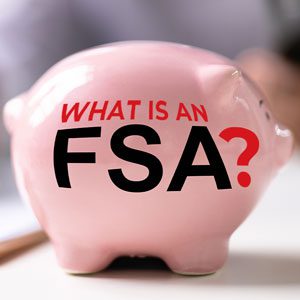
Employees in Preferred Provider Organization (PPO) health insurance plans usually enjoy co-pays and lower deductibles but pay higher premiums. To help offset these, they can reduce healthcare expenses with a tax-advantaged Flexible Spending Account (FSA). Here are answers to the FSA questions we get most frequently.
FSA FAQs
What is a Flexible Spending Account or FSA?
A FSA is an employer-sponsored, tax-advantaged employee benefit account. Through an FSA, employees can set aside pre-tax dollars from their paychecks to cover out-of-pocket healthcare expenses. These can be used to pay for eligible expenses for the account holder and qualified dependents.
What benefits do FSAs offer?
The primary benefit of FSAs is the tax savings they offer. Account contributions are made with funds deducted before payroll tax is calculated. In other words, the funds are not subject to Federal or State withholding or FICA taxes. The money then goes into an account used to pay for qualified healthcare expenses for the account holder and their dependents.
What is a “qualified” healthcare expense?
FSA funds may pay for healthcare expenses not covered by insurance, such as deductibles, copays, and coinsurance. However, they can also cover a long list of products and services, including medically necessary products, prescribed products, and those available over-the-counter (OTC).
- Letter of Medical Necessity — Some products and services deemed medically necessary but not covered by traditional health insurance may be FSA-eligible.
- Prescribed drugs and medications — Most drugs and medications that require a doctor’s prescription are eligible for FSA reimbursement, whether they are prescription-only or also available over the counter.
- General OTC products — Many products that do not contain drugs or medication are also eligible, which still surprises many account holders. These include such items as bandages, contact lens solutions, and sunscreen. However, items designed to support general health, such as vitamin supplements, are not eligible.
For the complete list of eligible healthcare expenses, please refer to IRS Publication 502.
Which dependents are qualified to use FSA funds?
Spouses and children are always considered dependents and FSA funds can be used for their expenses. However, anyone that the account holder can claim as an exemption for federal income tax purposes is also considered a dependent for FSA purposes.
How does enrollment work?
Existing employees may enroll in an FSA during an employer’s open enrollment period. New hires are generally provided a 60-day window during which they can enroll. Further, if your family status changes, you may have the option to enroll or change your enrollment depending on the plan setup. Please consult your HR department for plan details and available options.
How much may I contribute?
For 2026, the maximum annual FSA contribution limit is $3,400.
How does FSA funding work?
First, account holders will decide how much they want to contribute up to the annual maximum. That amount is deducted from each pay period in equal amounts.
When can the FSA contribution amount change?
After open enrollment, contributions may only change if you experience a qualifying event. Examples of qualifying events include marriage/divorce or a new family member who joined through birth or adoption. Again, please consult your HR department for more information.
How are funds accessed?
Some FSA account holders receive a debit card they can use to purchase eligible products and services. If not, the account holder will pay out-of-pocket and submit the expense for reimbursement. Receipts for reimbursement may be submitted via smartphone app, online participant portal, or by email, fax, or regular mail. Regardless of the payment or reimbursement method, always keep receipts and other purchase documentation should you be called upon for more information. Note that non-itemized cash register/credit card receipts and canceled checks are not eligible to serve as claims documentation.
What if funds pay for a non-eligible item?
The plan administrator will likely deny claims made for non-eligible healthcare expenses, so nothing further needs to be done. However, should an FSA debit card purchase prove ineligible after the transaction is complete, the funds must be returned to the account. That may be a future payroll deduction, check, or EFT payment. If the account holder fails to do so, the expense may trigger an income tax liability.
What happens to unspent funds?
Employers may offer participants one of three options as follows.
- Carryover – Some plans allow participants to carry over a specified dollar amount for use during the next plan year. Although the IRS sets a maximum Carryover amount, employers can choose to allow a lesser amount.
- Grace Period – Some plans include a 2.5-month grace period for participants to spend the remaining funds after a plan year ends.
- Use It or Lose It – In some plan setups, any funds unspent at the end of the year are forfeited to the employer, even if the participant was the only contributor.
Does Carryover apply to the next year’s election?
No. Carryover amounts are available in addition to the amount elected for the next plan year.
Are there single/family options, or can anyone have an FSA?
Unlike other benefits that address single/family coverage needs, both workers in a two-employee household may enroll in separate FSAs and contribute the maximum amount through their respective employers.
Can funds be transferred between FSA accounts?
No. Money cannot move between any FSA accounts.
FSA FAQs Answered
FSAs offer employees significant tax savings. These accounts offer various ways to access funds and a long list of eligible expenses. As employers look to control costs, FSAs offer an attractive benefit that may help them retain valuable talent without significant cost responsibility – while also helping employees save on their taxes. It’s a win-win for both parties.
Beneliance has provided Arkansas employers with comprehensive third-party employee benefits administration and compliance services since 1996. Please enter your email (above right) to receive notifications about new blog articles as they are published.



